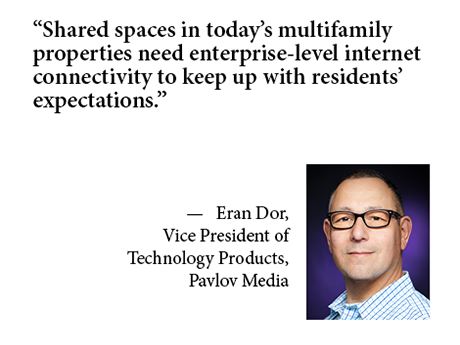The multifamily industry faces a major challenge. Final construction costs have grown 33 percent since 2019 interest rates and operational expenses are sky high; and rents may need to increase, where possible, to make deals feasible — an off-putting reality for residents.
One developer solution is smaller apartments, which make units cheaper. There is also a push to add more common-space amenities that are both valuable and less costly to include. These features include rooftop spaces, green areas and decks. However, to make these spaces truly usable for today’s multifamily residents, it is important to make them technologically flexible and to offer easy internet connection.

Pavlov Media
“The floor plans of most new-construction multi-dwelling units (MDUs) today are shrinking, and their amenities are expanding,” says Bryan Rader, president of MDU at networking and internet service company Pavlov Media. According to RentCafe, the average size of newly constructed apartment units fell by almost 6 percent in a decade, with half of that change occurring in the last year.
Rader likens it to the “resort-style community” approach, where hotel rooms are small, and guests are encouraged to spend time everywhere else on the property. Similarly, multifamily developers create shared amenities such as comprehensive fitness centers, yoga studios, cycling classrooms, dog parks, pickleball courts, pools and socializing and meeting spaces, which provide significant benefits to the residents and help justify higher rents.
Multifamily residents have come to integrate mobile technology into every part of their lives, and people want connectivity throughout their “expanded” homes. Similarly, property management staff expect connectivity everywhere on the property. Today, building operating systems depend on wireless sensors to deliver data that optimizes energy and water use — those sensors also need reliable networks. Property owners look to service providers like Pavlov Media, through its new Pavlov Spaces product set, to develop, install and manage such extended mobile internet networks.
Enterprise-Level Connectivity for Multifamily
“Higher quality connectivity is becoming more and more important to have everywhere,” says Eran Dor, vice president of technology products at Pavlov Media. “Property managers need good connectivity for software services and to communicate with potential renters and maintenance staff, wherever they are on the property. Residents in the gym want to listen to their music while they work out. People in meeting rooms need to make video conference calls.”
“Shared spaces in today’s multifamily properties need enterprise-level internet connectivity to keep up with residents’ expectations,” Dor continues. “A property might have a few wireless networking access points in any given area. Those access points are all tied into a management system, which coordinates their operation and, for example, keeps the access points from using each other’s frequencies,” so communications don’t get scrambled or dropped.
That is why new buildings need more extensive networking and connectivity than what sufficed even a few years ago. Older buildings often need retrofits to bolster what once was adequate to stay competitive.
Future Best Practices and Efforts to Exceed Residents’ Expectations
Advanced networking and connectivity require more than the simple process of buying hardware or getting a software upgrade. A management system must ensure each user at any given time has the right level of online resources for their activities. Reading emails on a phone requires less connection capacity than engaging in video calls. Current residents and staff all need varying types of access and a system flexible enough to account for their needs throughout the day.
Likewise, potential residents conducting in-person visits may also be checking their connection as part of the apartment vetting process. A slow connection may drive them away from certain properties.
Network design, implementation and management require expertise, planning, staffing and also ongoing monitoring. Proper operation isn’t a one-and-done experience. “Most of the time, we can know about issues that come up and solve them even before the customer knows about them,” says Dor. “There’s complexity in managing a communications network in a manner that caters to everyone’s needs.”
Planning for Network Efficiency

A proper installation begins with a site visit and audit, says Robert Gonzalez, a sales engineer at Pavlov Media. “What does the network structure look like?” he asks for each property. “What communications infrastructure do they currently have? Fiber? Ethernet cable? Are there existing wireless access points that let devices connect? If so, we can generate a map of every device that might be transmitting.”
This practice allows Pavlov Media techs to identify wireless signal sources and note which resources are overused or underused. Pavlov can then “declutter” and optimize the wireless space. “We try to limit what’s actually transmitting by disconnecting devices that don’t need to be transmitting (for example, if the device is idle),” explains Gonzalez.
These early efforts enable Pavlov Media to better create an efficient environment that allows expansion of access everywhere on the property, ensuring data for communications is prioritized and transmitted quickly and efficiently. Their process and attention to detail helped Pavlov Media win the Broadband Communities Broadband Provider of the Year award in May 2024.
“We come in and create better connectivity experience in a given space, and then leave it very organized so that you know where each cable and each access point comes from and where it goes,” Dor says. This benefits both residents and property managers.
But how long does this process take?
“Realistically, after obtaining a signed agreement, through creating all of the documentation, managing logistics, getting equipment on the ground — with the installation, testing and verification — all of that could be done in 30 days,” Gonzalez says.
And then, Pavlov Media manages the entire network, “so you get the best experience,” says Dor.
— By Erik Sherman. This article was written in conjunction with Pavlov Media, a content partner of REBusinessOnline. For more information on Pavlov Media, click here.


